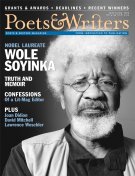Never trust the teller," D.H. Lawrence warned us. "Trust the tale." Sadly, recent revelations are forcing readers—confronted by a brand-new band of literary scallywags, hucksters, and hoaxers—to reconsider the veracity of the story as well as that of the storyteller.
Two of the most explosive and high-profile literary scandals lately have involved popular—even award-winning—memoirs.
Two of the most explosive and high-profile literary scandals lately have involved popular—even award-winning—memoirs. The most notorious of these, but not the most egregiously untruthful, is James Frey's best-selling rehab tome A Million Little Pieces (Nan A. Talese/ Doubleday, 2003). As has been widely reported, Frey added, embellished, expanded, and invented a lot of stuff to make his life story, well, more interesting. Still, Frey's foibles seem slight in contrast to the truly bizarre tale of Nasdijj, the supposed Navajo memoirist who wrote The Blood Runs Like a River Through My Dreams (Houghton Mifflin, 2000), which was a New York Times Notable Book, a finalist for the PEN/Martha Albrand Award for First Nonfiction, and the winner of a Salon Book Award.
In the summer of 1999, a writer named Nasdijj, claiming to be of Navajo decent, published an essay in Esquire about the death of his son from fetal alcohol syndrome. The article, a National Magazine Award finalist, detailed the boy's horrible hospital stays, the all-night crying fits, the massive seizures, his death, and his parents' inability to cope with the tragedy—all of it strong, stirring drama.
Shortly after the article's publication, Nasdijj was offered a book contract. The Blood Runs Like a River Through My Dreams was released to great acclaim, and was followed by two more books, The Boy and the Dog Are Sleeping (Ballantine, 2003), which won the 2004 PEN/Beyond Margins Award, and Geronimo's Bones: A Memoir of My Brother and Me (Ballantine, 2004). All three books describe a sorrowful and depressed modern Native American life and lifestyle in startling detail—none of it, as it turns out, true.
However, it took more than six years for this literary hoax to be completely exposed—most thoroughly by Matthew Fleischer in LA Weekly on January 25. Fleischer's investigation led to the revelation that Nasdijj was actually a white man—a former gay-erotica novelist named Timothy Patrick Barrus. While many individuals in the literary world had nagging doubts about Nasdijj's writing for years—including Native American writer Sherman Alexie and New York Times Book Review contributor Ted Conover, among others—the charade continued. Since Fleischer's report was published, however, Nasdijj has disappeared from public life, and his Web site was taken offline.
"This should be a wake-up call: If you have to lie to make your life story more dramatic, more interesting, then don't write a memoir," says Oscar Villalon, book editor of the San Francisco Chronicle. "Write your ideas into a story or a novel, or an essay, or a poem—whatever."
That, it seems, is exactly what JT LeRoy was thinking when, in 2000, the same year Nasdijj got his first book contract, the young, cross-dressing boy-hustler published his first book, Sarah (Bloomsbury). While the book was positioned as a novel, the author's shocking backstory implied that it was autobiographically inspired, which lent it tremendous prurient appeal. LeRoy, an HIV-positive teenage prostitute, supposedly wrote Sarah after being encouraged by his San Francisco psychologist, who suggested that he channel his tragic childhood experiences into writing. The book captured the imagination of many readers, becoming a national best-seller. And LeRoy parlayed his newfound fame into connections with such notables as Dennis Cooper, Courtney Love, Madonna, Dave Eggers, Michael Chabon, and others. It appears all of LeRoy's connections and friendships were maintained via telephone, fax, and e-mail. Why? The boy wonder was a fake, a creation of the author of Sarah and its follow-up, the ironically titled story collection The Heart Is Deceitful Above All Things (Bloomsbury, 2001), which was also adapted and made into a film directed by and starring Asia Argento.
The writer formerly known as JT LeRoy is actually Laura Albert, a woman in her forties with a middle-class background, living in San Francisco. Albert, with the help of her long-term partner, Geoffrey Knoop, and his half-sister Savannah (who, wearing sunglasses, a wig, and a hat, appeared as LeRoy in public), managed to carry on the hoax for over five years. Not only did they publish novels under the name LeRoy—which many readers have begrudgingly excused (it is fiction, after all)—but journalism pieces as well. LeRoy's publishing credits include articles in Spin, Nerve, the Oxford American, and the New York Press, a fact that has many in the publishing industry more than a little peeved.
"The funny thing is, I don't have a problem with an invented persona for an author, as long as that person is writing fiction," Villalon says. "The main problem with JT LeRoy, though a lot of people were conned to advance the author's career, was 'the LeRoy' started writing journalism. To me, as to anybody else working at a newspaper, perhaps, that was stepping way over the bounds of artistic license." In other words, a fake is fine in fiction, but not in a genre that is meant to purvey the truth—no matter how many writers like Frey, Nasdijj, and LeRoy may sully that term's definition.
While each of these fantastic deceptions produced real victims, in the end it seems reasonable to believe that the publishing industry will survive and move on in an era of heightened skepticism—and, hopefully, a good deal more fact-checking. After all, the amount of trust (and money) readers are willing to spend may depend on it. But, then again, two months after Frey's lies were revealed, A Million Little Pieces was still sitting pretty at No. 2 on the New York Times best-selling paperback nonfiction list.
Joe Woodward is the author of Small Matters: A Year in Writing.









